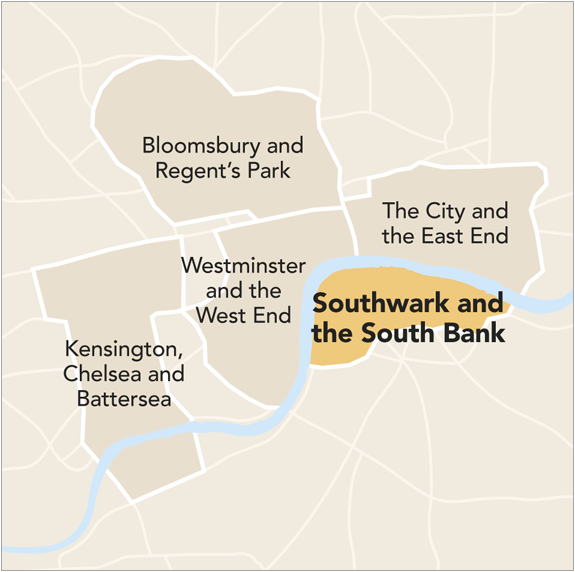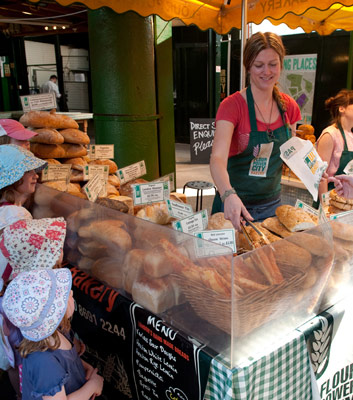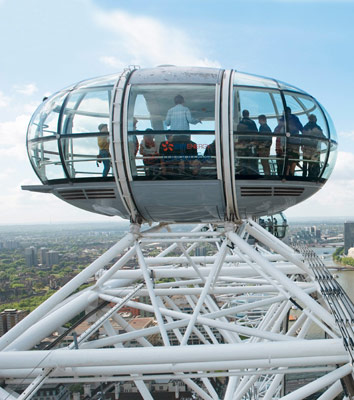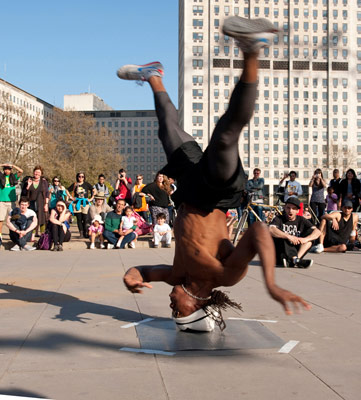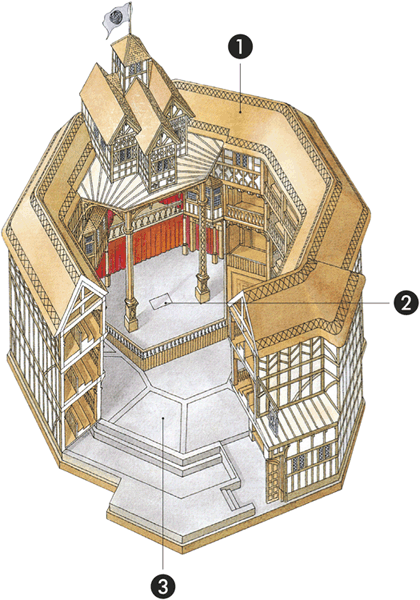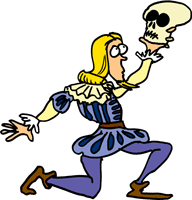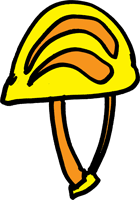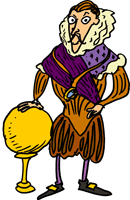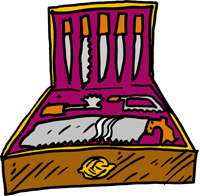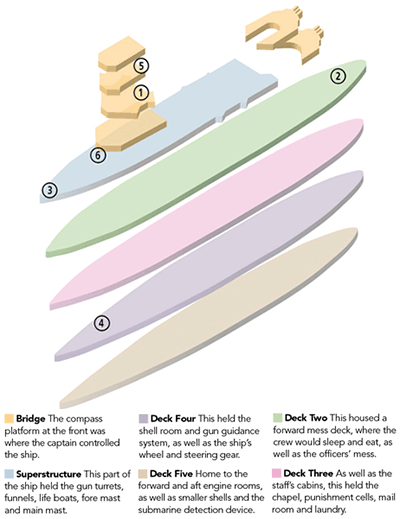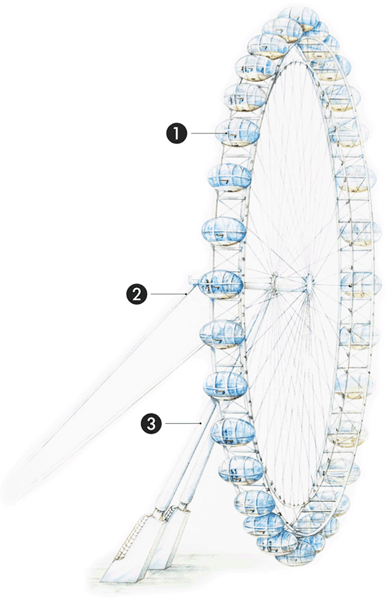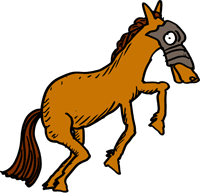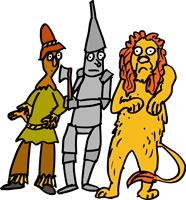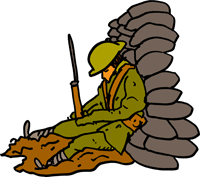< Southwark and the South Bank
Shakespeare’s Globe and Around
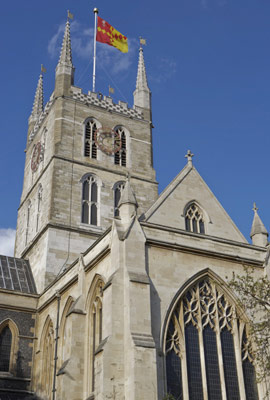
Southwark Cathedral, the oldest cathedral in London, dating from the 7th century
The Globe is a genuine time-travel experience for children, set in a thatched theatre straight from a picture book. River bus services dock at Bankside Pier, opposite the gates. The theatre is just one of several attractions on the South Bank, so book ahead for the auditorium tour, then build the day around it. Families can happily spend a full day on museum-going, pavement-dining and people-watching – while barely encountering a single car.
1. Shakespeare’s Globe
2. Tate Modern
3. Clink Prison Museum
4. The Golden Hinde
5. Southwark Cathedral
6. The Old Operating Theatre
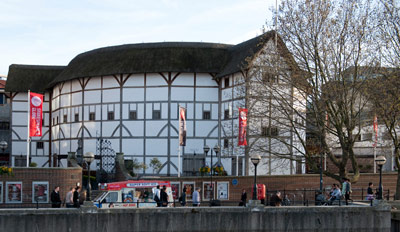
The open-roofed Shakespeare’s Globe theatre – a lively experience for all
1. Shakespeare’s Globe
The roar of the greasepaint, the smell of the crowd
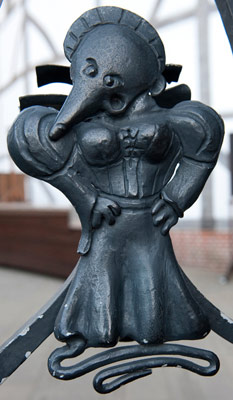
Detail from the Globe’s gates
In Shakespeare’s time, going to the theatre was not the genteel experience it is today. Rival acting troupes competed to attract an audience – who would drink and shout at the actors during plays packed with murder, magic and comedy. The original Globe was built nearby in 1599, after Shakespeare and his company, the Lord Chamberlain’s Men, transported a playhouse, timber by timber, across the Thames from Shoreditch. Today’s open-air theatre, a near replica, opened in 1997.
Key Features
1. The building It uses 16th-century materials, such as hand-made bricks and wooden pegs, not nails. The thatched roof was the first in the city since the Great Fire of London.
2. The stage Look out for trapdoors (above and below), which allow surprise entrances by devils or ghosts in puffs of smoke, or angels and fairies flying down on ropes.
3. The audience 3,000 people would cram inside for a play. It cost a penny to watch from the yard – in summer, it got so smelly, these spectators were called “penny stinkards”.
• The actors Until 1661, boys as young as 13 performed the female roles. It is believed that many died early, poisoned by the lead in their make-up.
• The plays Hamlet, Macbeth and Julius Caesar all had their premieres at the original Globe Theatre. Shakespeare often performed minor roles in his own plays.
• The theatre season runs from April to October. After the monthly Child’s Play workshops, kids get to sneak in to watch the end of the Saturday matinee.

Left
Interior of the theatre Right Child’s Play workshop
Kids’ Corner
Stage craft
There is plenty to get your hands on at the Globe…
Find a farthingale, a doublet and a ruff – which parts of the body were they for?
Find a cittern, a sackbut and a tabor – which would you pluck, blow or beat?
Gross!
Shakespeare’s audiences liked violent scenes, because blood and battle were part of everyday Tudor life. On the way to the theatre, people walked past the heads of criminals, traitors and pirates put on spikes on London Bridge!
Open sesame
The Globe’s amazing iron gates are decorated with every plant and animal mentioned in a Shakespeare play. From the river side, see if you can spot a crab, a dolphin and a snake. Which creature completes this sequence: vulture, crow, dove and… ?
Fire! Fire!
Elizabethan special effects included cannons and fireworks to recreate battle scenes. The Globe burnt to the ground in 1613, when a cannon set the roof ablaze. Everyone escaped alive – although one man’s trousers caught fire! Can you spot how the theatre is protected from fire hazards today?
2. Tate Modern
Shattering, splattering, exploding… art
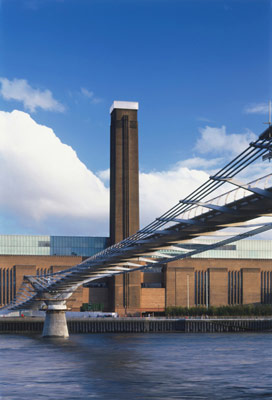
The Millennium Bridge over the Thames links St Paul’s and Tate Modern
There’s no need to worry whether children will enjoy Tate Modern. Whether it’s a Jackson Pollock splatter painting, Henri Matisse’s colourful collages, or Claes Oldenburg’s make-believe hamburgers, chances are they have already created something along the same lines at school or in their bedroom. If not, they soon will, after a wander around London’s most mind-expanding art gallery. Copying Niki de Saint Phalle, who created her paintings by shooting at them, should probably be discouraged, however.
Housed in the tall-chimneyed former Bankside Power Station, Tate Modern was a smash hit from the moment it opened in 2000, and a £215 million redevelopment has doubled the exhibition space to help soak up its five million annual visitors. The gallery offers masses for children. A dedicated team occupies the family concourse on Level 3 every weekend afternoon, suggesting art trails and challenges for kids aged five and above. The “Interactive Zone” on Level 5 is available full time, with touch-screen consoles and video clips that illuminate and explain the collection. The children’s audio tour is strong on quizzes and puzzles, and there’s even a “Tate Trumps” game to download as an app for iPhone – collect seven favourite works then pit them against art chosen by friends. Exploring the gallery is less daunting than it first appears: while there are seven storeys in all, the permanent collection is only on levels 3, 4 and 5, and is grouped by theme into four wings. A great approach is to let kids lead the way, wandering the 20 or so rooms on each floor in search of appealing pieces. Rewarding stops include Room 2 of the “Poetry and Dream” wing, for Dali; Room 1 of “Structure and Clarity”, for Matisse; and Room 1 of “Energy and Process” for Malevich. Also look for Richier and Rothko in the “Transformed Visions” wing. Note that the Tate often loans out or removes work for restoration so works may not always be on display. Don’t miss the Turbine Hall, right at the bottom, housing a single, huge installation.
Kids’ Corner
Make a monster
The Surrealist artists invented a drawing game to create weird creatures. Here’s how to play…
-
Fold a sheet of paper to give four equal horizontal parts.
-
With a friend, take it in turns to draw a different part of the body on the sheet – head, body, legs and feet. Start with a head, copied from an artwork at Tate Modern, then fold the paper over to hide the picture, leaving just a tiny bit showing so the next body part can be added.
-
Unfold the paper to reveal your Tate Modern monster!
Memory game
In Tate Modern’s “Energy and Process” wing, find the builder’s workroom created by artists Fischli and Weiss. Spend one minute memorizing the objects on the big table, then turn around and see how much you can remember.
-
What is the tallest object?
-
What colour is the cycle helmet?
-
How many biscuits are there?
Handy Andy
Why not make your own Andy Warhol portrait like the ones at Tate Modern? Get a photograph of yourself, a friend or maybe your favourite pop star or sports star. Photocopy it four times in black and white, as big as you can. Now colour each copy using a different crayon. Done! Your “Warhol” is ready for the wall.
3. Clink Prison Museum
The original London dungeon
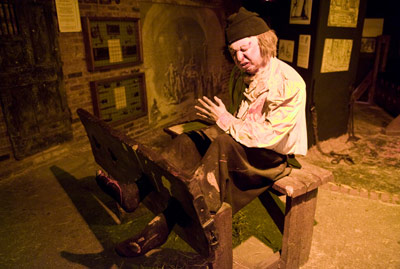
Waxwork inmate undergoing punishment at the grisly Clink Prison Museum
Medieval Southwark was outside the jurisdiction of London’s civic authorities, and was a lawless place notorious for bear fights, drinking dens and brothels – all licensed by the bishops of Winchester, whose palace stood here on the south bank of the Thames. A gaol was needed to control the area, and in 1144 the Clink was opened – a place so infamous that its name became a byword for prisons across the land.
Inside the small, dingy cells of this subterranean attraction, waxwork inmates, recorded shrieks and replica torture equipment are used to tell the gory story of crime and punishment up to 1780, when the Clink locked up for the last time. Information boards describe a 12th-century trial by ordeal (walk across red-hot irons without injury and you’re innocent) and the priestly persecutions of Bloody Mary. It is more histrionic than historical, and maybe a bit too spooky for the under-8s. Ghoulish children will enjoy trying on the scold’s bridle or placing their head on the executioner’s chopping block. Visitors are able to download a picture of their visit afterwards.
4. The Golden Hinde
Ahoy there me hearties!
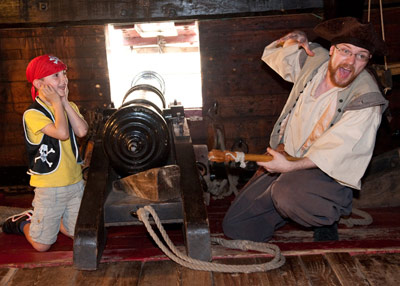
Dressed up and pretending to fire a cannon on the Golden Hinde
This beautiful replica of a Tudor galleon sits majestically on the river alongside the cafés and office blocks of Bankside, as if moored there just a minute ago by pirates. Indeed, miniature mutineers swarm aboard regularly, during the pirate days and sleepovers staged for families.
The Hinde is a full-size reproduction of Sir Francis Drake’s flagship, which circumnavigated the world in the 1570s, discovering California and plundering much Spanish loot along the way. Rewards could be high – after one profitable trip, even a lowly cabin boy became the equivalent of a millionaire.
A rudimentary handout describes the decks, rigging and artillery – but aim to visit at the weekend if possible, when excellent tour guides are on board to help. Sit in Drake’s chair in the captain’s cabin and marvel at how the cramped quarters once accommodated up to 80 crew – even little ones will need to duck down to explore the gloomy gun deck. Most Saturdays there are costumed family fun days: grab a cutlass and eye-patch and learn how to weigh anchor and fire a cannon.
Kids’ Corner
Hero or villain?
Sir Francis Drake led the English fleet to victory against the Spanish Armada in 1588, but he was also a kind of pirate. In 1579, he captured more than 26 tons of treasure from the Spanish galleon Cacafuego. He sailed home with it to Queen Elizabeth I, who knighted him on deck and took £160,000 – enough to wipe out the national debt.
Shiver me timbers!
Try this Golden Hinde quiz
-
On average, how tall do you think Drake’s sailors were? (Clue: ceilings were very low)
-
Can you find a lion’s head on the ship? What was it for? (Clue: sailors were superstitious)
-
Why are the decks red? (Clue: handy during battle)
5. Southwark Cathedral
Pilgrims, poets and posh provisions
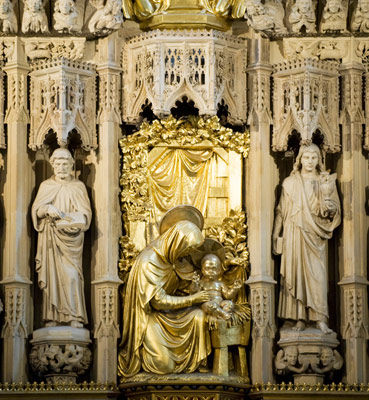
Gilded Mary and Jesus, a detail of the Great Screen, Southwark Cathedral
The “archaeology chamber” in Southwark Cathedral’s millennium wing is a window on nearly 2,000 years of worship beside London Bridge. A 4th-century Roman religious icon was unearthed here, and there is a stone coffin from the medieval Priory of St Mary Overie.
The church we see today is mostly 14th century. Geoffrey Chaucer’s pilgrims in The Canterbury Tales began their journey from a nearby tavern, and the fabulous tomb of Chaucer’s contemporary John Gower lights up the cathedral’s nave with its carousel colours – red, green and gold. Look out for a 500-year-old stone “corpse”, emaciated in its shroud – perfect for spooking the children. However, the best known memorial remembers William Shakespeare, who spent 12 years working at the nearby Globe Theatre – characters from some of his plays cavort in a stained-glass window above.
From Thursday to Saturday, the stalls of
Borough Market lap around the cathedral railings, adding greatly to the atmosphere of the neighbourhood. London’s oldest food market was chartered by Edward III in 1406, although it is unlikely to have sold ostrich burgers or Burmese curry powder back then. The market now specializes in delectable ingredients from across Europe and beyond, and sampling the food is encouraged – but steer clear on Saturday mornings after 10am, when the area gets super-busy.
Kids’ Corner
Market maths
At Borough Market, track down the list of tolls that traders had to pay 100 years ago. If you wanted to sell these goods, what was the total fee?
Five sacks of peas……………….
Two bushels of grapes…………
A basket of eggs…………………
TOTAL _____
6. The Old Operating Theatre
The church that dripped blood
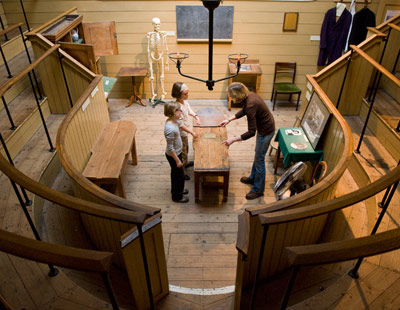
The small surgeon’s table at the heart of the Old Operating Theatre
This macabre museum makes an interesting counterpoint to the
London Dungeon, just around the corner. Whereas the Dungeon is a schlocky horror show, this is an authentic slice of Victorian gore, inside the attic of 300-year-old St Thomas’s Church. It shows off Europe’s oldest surviving operating theatre, established in 1822 to serve nearby St Thomas’s Hospital, where student surgeons once gathered to watch limbs being chopped off poor patients – without anaesthetics.
Howls of real torment once rang through the rafters here, and the museum’s entrance could hardly be spookier – it is reached via a spiral staircase in the church’s tower. The first chamber to visit is the Herb Garret, storehouse of the hospital apothecary in centuries past, and stacked with musty animal skins and bizarre potions, much like a witch’s pantry. Harry Potter fans will adore the vibe here. The operating room is a creepy space too – literally a theatre, with the surgery table as the stage, steeply banked viewing stands, a box of sawdust to soak up the blood of amputees and a corridor of murderous-looking surgical instruments.
Kids’ Corner
Feeling sick
Only poor people had surgery at The Old Operating Theatre. In the 1820s hospitals were full of infections, so rich patients preferred to be operated on at home – usually on their kitchen table!
< Southwark and the South Bank
HMS Belfast and Around
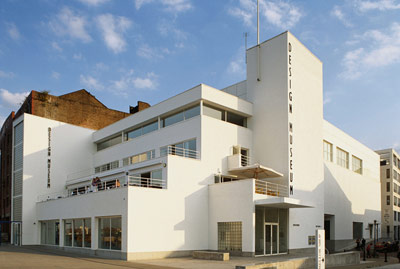
The Modernist building housing the Design Museum, founded in 1989 and one of the first design museums in the world
HMS Belfast, the most powerful battle cruiser in Britain’s World War II fleet, is now a floating museum. Visiting with kids is an immersive experience, but avoid inclement days, and check the website for kid’s activities. Back on shore, this pedestrianized strip of riverside is perfect for families. Young history buffs will love trying on the uniforms in Winston Churchill’s Britain at War Experience.
1. HMS Belfast
2. The View from The Shard
3. Winston Churchill’s Britain at War Experience
4. Design Museum
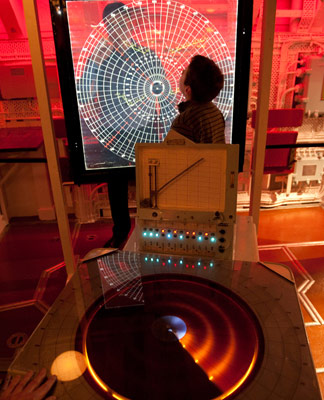
Inside the interactive Operations Room on board HMS Belfast
1. HMS Belfast
Action stations – on one of Britain’s great warships
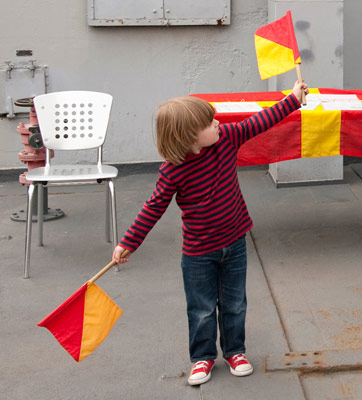
Signalling with semaphore flags
She was built in 1938, in the same Northern Irish shipyard as the Titanic, but on a quiet day, HMS Belfast feels more like the Marie Celeste. What could be more atmospheric than exploring a great warship in battle trim, populated only by visitors and the ghosts of the 800 seamen who once manned her? Generators buzz, orders crackle through the speakers and most areas are accessible to children, who can swarm down ladders and along gangways, into gun turrets and mess decks accompanied by the lively audio guide.
Key Features
1. Admiral’s Cabin HMS Belfast became the flagship of Britain’s Far East Fleet, and in the admiral’s command room, children can don uniforms and scan for enemy craft.
2. Quarterdeck The ship’s parade ground and exercise yard, this was mainly reserved for officers. It is where visitors board – don’t forget to salute!
3. Anchor If the electric winch failed, it took 144 men to turn the capstan and raise the ship’s main anchor. It is as heavy as an elephant (5.5 tonnes).
4. Shell Room The shells line up like giant bowling pins here. They were loaded into a carousel and then hoisted up to the four main gun turrets.
5. Operations Room In the ship’s nerve centre, Belfast’s finest hour is re-created – when she helped sink the German battleship Scharnhorst at the Battle of the North Cape in 1943.
6. Gun Turret Swivel in the turret captain’s chair and imagine unleashing Belfast’s guns on a target 23 km (14 miles) away.
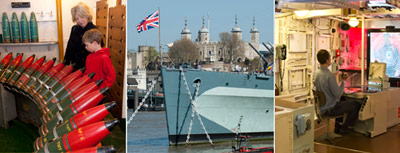
Left
Shell room Middle HMS Belfast with the Tower of London in the background Right Operations room
Kids’ Corner
Ship speak
Sailors on HMS Belfast used lots of naval slang. Try to work out the meaning of the sentence below – all the mysterious words can be found on board… “I had too much grog and dropped my nutty in the dhobi. Now I’ve got to go to the Naafi!”
On the radar
HMS Belfast was one of the very first ships to be armed with radar. A radar machine sends out radio waves, which bounce back off enemy ships and planes, revealing their position, direction and speed. Can you track down the Admiralty Fire Control Table, deep in the ship’s hull? This big computer used radar signals to work out the right angle and height for the ship’s guns to reach their target.
Read the flags
Ships once communicated via flags at sea. Each letter of the alphabet is represented by a different flag, so that messages could be displayed on a ship’s mast. What do these flags spell out?
Can you write out your own name in nautical flags?
2. The View from The Shard
Amazing 360° views of the London skyline

Visitors enjoying panoramic views of the city from the top of The Shard
The tallest building in Western Europe, The Shard is designed by architect Renzo Piano. One of the latest skyscrapers to dominate the London skyline, it is 310 m (1,016 ft) high and houses offices, restaurants, the five-star Shangri-La hotel, exclusive residential apartments and the country’s highest observation gallery, The View, reached by high-speed lifts. The entrance to The View is via Joiner Street.
Situated near the top of The Shard, on floors 68, 69 and 72, the public galleries feature multimedia displays that provide context to the views. Adults, and especially kids, will enjoy travelling skyward in “kaleidoscopic” lifts that use video screens and mirrors to create the effect of soaring through the iconic ceilings and roofs of London. On arrival at the “cloudscape” on Level 68, head upwards to the tripleheight, main viewing gallery at Level 69, where unobstructed 360° views of the capital are revealed. The city of London is brought to life through 12 telescopes, enabling people to explore the city around them in real time. These free-to-use instruments also help visitors identify 250 famous landmarks and places of significant interest, while providing information about them in 10 languages. For a profound experience, go to the viewing gallery at Level 72 – the highest habitable level of the building. This level is partially open-air, and is considered the highest vantage point in Western Europe. Visitors are surrounded by giant shards of glass that form the top of The Shard and can listen out for the sounds of the bustling city below.
3. Winston Churchill’s Britain at War Experience
A recreation of London life – and death – during the Blitz
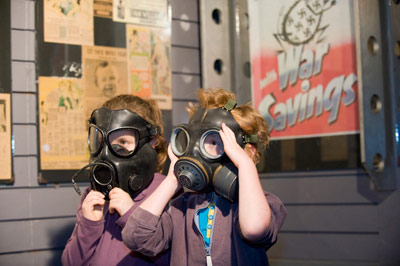
Trying on gas masks at Winston Churchill’s Britain at War Experience
Among London’s many museums of soldiery and warmongering, this is perhaps the most poignant, exploring life on the home front during World War II. It begins strongly: air raid sirens blare and an elevator whisks visitors down into a recreated Tube shelter; Londoners would rush to stations to shelter from Nazi bombs. Mannequins huddle on makeshift bunks, posters warn that “Careless talk costs lives”, and an excellent newsreel uses real-life testimonies to tell the dreadful story of the war.
The main galleries feature mostly low-tech displays of costumes, cuttings and memorabilia: children can listen to recordings of factory girls and young evacuees talking about life in wartime; and can try on tin hats, gas masks and uniforms. Many exhibits have been donated by visitors, giving the museum a make-do-and-mend feel that is appropriate for the period. The big finish is a noisy, smoking evocation of houses being bombed during the Blitz – a bit scary for very young children, and slightly tasteless for everyone with its scattering of severed limbs.
Kids’ Corner
Wartime food
During World War II, many ingredients were very scarce and lots of weird recipes were invented. How would you like:
- Carrot marmalade
- Parsnip sandwiches with banana flavouring
- Mock goose (lentils and breadcrumbs).
At the Britain at War Experience, there’s even a cardboard cake. What was it used for?
4. Design Museum
A modern temple to design
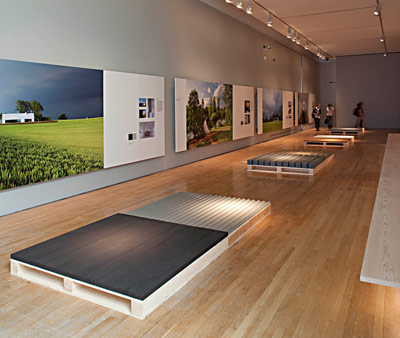
One of the ever-changing exhibitions at the Design Museum
A big part of the appeal of this museum is its setting on Butler’s Wharf, a chunk of London’s revitalized Docklands. The approach is along Shad Thames, whose overhead walkways were used in Victorian times to wheel tea and spices from the quayside, but now link luxury loft apartments, their courtyards parked with convertibles instead of carthorses. A stroll around here will certainly appeal to kids’ imaginations. The Design Museum itself is arranged over three floors of an appropriately cool white building. There is no permanent collection, instead temporary shows focus on avant-garde architecture, furniture or fashion. It can be a bit esoteric for children, but there’s a family workshop or tour most months, linked to current exhibitions, while the free under-12s’ activity sheet encourages kids to doodle their own designs.
If the kids enjoy this sort of thing, consider combining a visit with the nearby Fashion & Textile Museum (83 Bermondsey Street, SE1 3XF; 020 7407 8664;
www.ftmlondon.org; 11am–6pm Tue–Sat), which lays on school holiday workshops.
Kids’ Corner
Do you know…
Winston Churchill often appeared in public with a cigar in his mouth, and the habit started at an early age. When he was 15 his mother implored him to give up the habit, writing in a letter, “If you knew how foolish and how silly you look doing it you would give it up, at least for a few years.” She didn’t just rely on rhetoric, though; she even turned to bribery. If Churchill would give up smoking for six months, she would get him a gun and a pony. He agreed to this deal.
< Southwark and the South Bank
London Eye and Around
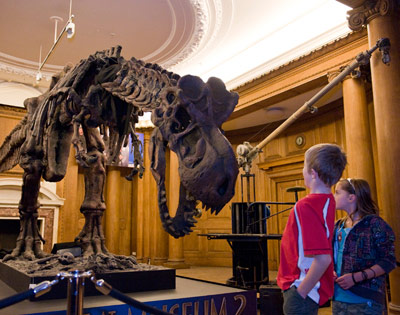
Dinosaur skeleton from Night at the Museum 2 at the London Film Museum
Erected in 2000, the London Eye is a genuine wow for kids, especially if approached on foot from Waterloo station. Book ahead to ride – but not before checking the weather forecast, because rain blots the views. That’s good advice for the eclectic South Bank, which can be bleak on a wet day, although it embraces the National Theatre, the London Aquarium and Britain’s biggest cinema screen as well as a motley crew of street entertainers.
1. London Eye
2. National Theatre
3. BFI Southbank
4. Gabriel’s Wharf
5. Southbank Centre
6. Sea Life London Aquarium
7. London Dungeon
8. London Film Museum
8. Imperial War Museum (IWM)
9. Florence Nightingale Museum
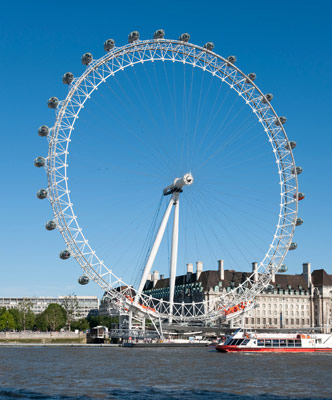
The London Eye in front of the Sea Life London Aquarium, on the South Bank
1. London Eye
Take a spin over London
How does it feel to be a seagull soaring above London? Find out during a ride on “the world’s tallest cantilevered observation wheel”. Rising 135 m (443 ft) above the Thames, the London Eye opened as part of the city’s millennium celebrations. A serene 30-minute ride in one of its glass capsules offers views stretching 40 km (25 miles) – on a clear day you might even be able to see Windsor Castle!
Key Features
1. The capsules Each of the 32 capsules weighs 10 tonnes, can hold 25 passengers and rotates at 26 cm (10 in) per second. Celebrity fliers have included Prince Harry, Kate Moss, the Jonas Brothers…and Kermit the Frog!
2. The spec The wheel cost £70 million, weighs 2,100 tonnes and is supported by two 60-m (197-ft) cables. It was floated up the Thames in sections, assembled and then slowly raised using the cables.
3. The structure Although no longer the world’s tallest observation wheel (the 165-m (541-ft) Singapore Flyer takes that prize for now) it is the largest cantilevered wheel, as it is supported by an A-frame on one side only.
• The ride The slow-moving capsules mean the wheel can be boarded without stopping, and the gentle ascent is entirely unscary.
• Extras A 4-minute “4D” cinema show in the ticket hall is free for London Eye travellers. It uses dry ice, bubbles and “real rain” to simulate an aerial journey over London.
• The view On a clear day, Windsor Castle, 40 km (25 miles) west of London, is visible – although Wembley Stadium’s arch, 12 km (7 miles) away to the northwest, is a better bet.

Left
Houses of Parliament Middle ‘4D’ cinema show Right Slow-moving capsules
Kids’ Corner
It’s “wheely” big!
Can you answer these crazy questions? Challenge a friend and see who gets closest:
-
The Eye is 135 m (443 ft) tall – how many London phoneboxes is that?
-
It weighs 2,100 tonnes – how many London taxis is that?
-
It carries 800 people on each spin – how many London bus loads is that?
Tall stories
Which of these world-famous landmarks is almost the same height as the London Eye: the Eiffel Tower, the Statue of Liberty, or the Great Pyramid of Giza?
I-spy in the sky
From high up in the Eye it’s possible to peek down on London’s spies! Look south from the capsule, along the river past the Houses of Parliament. The building just to the right of the second bridge, with a gold roof, is MI5, where Britain’s homeland security agents work. Further down, on the left of the third bridge, is MI6 – HQ for secret agents working overseas. Any sign of James Bond?!
2. National Theatre
London’s top family arts destination
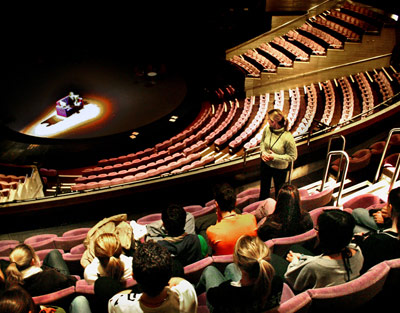
Enjoying an auditorium tour at the Olivier Theatre, part of the National Theatre
Britain’s largest theatre complex was built on the South Bank in 1976. It was designed by Sir Denys Lasdun in the Brutalist architectural style, with lots of concrete and sharp edges, which people seem to either love or hate. Luckily it’s the interior that counts, and that has three auditoria showing a terrific mix of classic drama and new writing, providing something for everyone. It’s worth just dropping in, too, as the lobby areas embrace four restaurants, two exhibition spaces (photography figures strongly) and a small stage for free live music before curtain-up most evenings.
Guided tours include a visit to the fan-shaped Olivier Theatre, modelled on ancient Greek theatres, and a glimpse of the scenery workshops backstage, where children can get up close to props from recent plays, such as Alice the mare, a puppet from the smash-hit show War Horse, based on Michael Morpurgo’s novel for children. The liveliest time to come is June to September, when the theatre hosts a madcap family performance festival, mostly outdoors and largely free. It might include trampolining Belgian clowns in Theatre Square or interactive puppetry in the Playspace, an inflatable auditorium just for kids.
Kids’ Corner
Giddy up!
War Horse is the National Theatre’s most successful play ever. It uses life-size puppets to tell the story of a boy, Albert, and his horse, Joey, who is sold to the cavalry during World War I. Joey is worked by three puppeteers: two inside his body, and one moving his head. He has eight “understudy” legs backstage, in case of breakages!
3. BFI Southbank
Britain’s largest big-screen experience
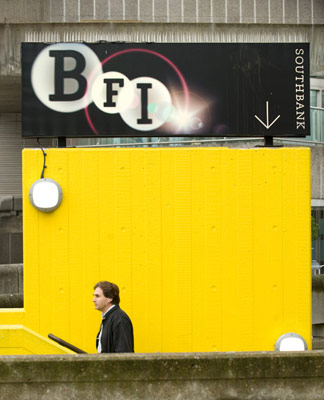
BFI Southbank, a big attraction for film buffs of all ages
Crouching right under Waterloo Bridge, London’s art-house cinema hub opened as the National Film Theatre in 1953, and now has four screens, a gallery for celluloid-based art and a very slick cocktail lounge. The programme generally has something for families.
For children who need a screen fix even when sightseeing, there is also the free Mediatheque room: simply choose a booth and access a menu of 2,000 movies and TV shows from the world’s biggest screen archive. The children’s list spans Robin Hood and The Railway Children to Watership Down.
Nearby, the more commercial BFI IMAX is contained in a giant glass drum outside Waterloo Station, where the likes of Harry Potter and Shrek loom 20-m (66-ft) tall on Britain’s largest screen. Look out for the monthly Film Funday workshops, where kids get to animate their own movie before the main screening, or dress up as their heroes. A special children’s menu is also available at the restaurant.
Kids’ Corner
Have you seen it?
In 2005, the BFI (British Film Institute) made a list of the “Top 50 films you should see by age 14”. Here are 10 of the more famous ones – how many of them have you seen?
-
Beauty and the Beast
-
Billy Elliot
-
ET The Extra-Terrestrial
-
Finding Nemo
-
The Princess Bride
-
Jason and the Argonauts
-
Star Wars
-
Raiders of the Lost Ark
-
The Wizard of Oz
-
Toy Story
4. Gabriel’s Wharf
Boutiques and bicycles
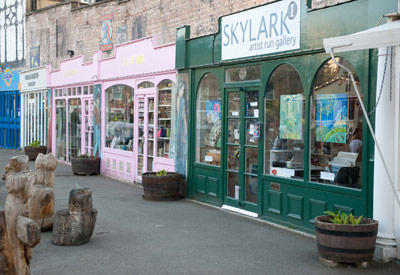
Some of the pretty, pastel-painted buildings at Gabriel’s Wharf
It’s heartening that this little oasis of “alternative culture” can thrive in such a go-getting strip of Central London, and that’s thanks to Coin Street Community Builders – a gang of residents who banded together in 1984 to save the site from property developers. They’ve created a perky area of pastel-painted craft studios and cafés right by the Thames, with lots of appeal for families: it has a giant mural, bicycle hire (see
Sightseeing tours), and a bevy of carved wooden beasts, some of them made for tots to ride on. Just beyond looms the Art Deco
OXO Tower, with a small art gallery on the ground floor, bijou design shops along its balconies and a viewing platform at the summit.
Kids’ Corner
Up on the roof
When the Oxo Tower was built, the owners wanted to advertise their beef stock product called Oxo, on the outside of the building. But London’s city council said no. Take the lift to the amazing viewing platform on the eighth floor, and see if you can spot the clever way they got around this problem.
5. Southbank Centre
Music, dance, art, poetry, comedy… and purple cows
The Southbank Centre comprises three main venues, the Hayward Gallery, the Queen Elizabeth Hall and the Royal Festival Hall, which together showcase all manner of music, art, dance and performance.
The Hayward Gallery is a cavernous contemporary art space that often puts on innovative and interactive shows. For example, its 2011–12 “Move” exhibition let visitors swing on monkey rings, don gorilla suits and pummel punchbags. The Royal Festival Hall, built for the 1951 Festival of Britain, is filled with exhibition, performance and eating areas. Its eclectic line-up includes Friday Lunch, a free gig in the Foyer Bar (Level 2); and family workshops.
Each April the Centre stages a summer arts festival in the Udderbelly, a pop-up theatre in Jubilee Gardens set inside a giant upside-down purple cow. The programme includes family shows, music and theatre.
Kids’ Corner
Get soaked!
The Royal Festival Hall fountain is designed so you can walk into “rooms” created by the jets of water. See if you can enter all four rooms without getting wet. Oh… but just in case, better take along some dry clothes!
6. Sea Life London Aquarium
Find Nemo and outstare a shark
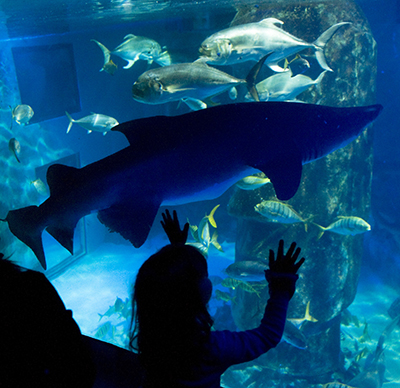
Mesmerising creatures of the deep in the Sea Life London Aquarium
It is said that we know more about deep space than we do about the deep oceans. After visiting the London Aquarium, that claim seems entirely plausible. Its three floors of tanks showcase more than 500 marine species, including amazing fish that change colour, fish that change sex, fish that glow in the dark, and fish that look like snowflakes, butterflies or boulders.
The aquarium tunnels under County Hall, its galleries snaking through vaults that echo with ambient music, which can feel a bit claustrophobic at busy times. A walk-through glass tunnel brings children eye to eye with turtles, rays and murderouslooking sand tiger sharks. In other zones, kids may get to stroke a starfish or help out with the daily fish feeds, though interactivity is limited. The big climax is the Shark Walk, which dares visitors to tiptoe over a glass platform right above the killers.
Kids’ Corner
Something fishy
Can you name the sea creatures with these bizarre traits? They are all at the London Aquarium.
-
Which one pushes its stomach out of its mouth to eat?
-
Which one collects shells to make gardens and forts around its home?
-
Which one has no heart, blood or gills?
Where’s Nemo?
Clownfish and sea anemones live happily side by side. The anemone protects the clownfish by stinging predators that come near. In return, the clownfish gobbles up the bugs that live on the anemone. This helpful, sharing relationship is called “symbiosis”. Can you find other examples of symbiosis at the London Aquarium?
7. London Dungeon
Gruesome tales of London’s grisly past
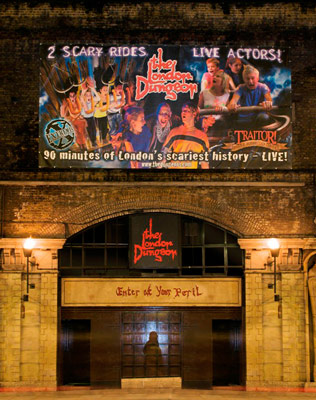
The entrance to the London Dungeon – enter if you dare
After 40 years under London Bridge, the Dungeon has moved to a larger space in the vaults beneath County Hall. The all-new attraction brings 1,000 years of authentic British history to life with talented live actors and special effects. Visitors are ushered into the Dungeon through a gloomy labyrinth of torchlit rooms showcasing dark chapters from the city’s past – from the Black Death and the Guy Fawkes’ conspiracy to blow up Parliament to Sweeney Todd and Jack the Ripper – via dismembered corpses and heads on spikes. There’s a generous helping of audience participation: children should stand at the back or expect to be locked in a torture chamber, burnt at the stake or operated on by the butcher surgeon. It’s all played for laughs (watch out for chamber pots being emptied from medieval windows) – the young cast act with gusto and the Ripper rooms are especially atmospheric – though younger children might find themselves howling more in terror than delight.
Kids’ Corner
Hanging around
In 1750, Londoners could be hanged for more than 150 different crimes. Can you guess which one of the below you would not be executed for:
- Picking someone’s pocket
- Stealing rabbits
- Cutting down fruit trees
- Playing loud music on a Sunday
- Appearing on the highway with a sooty face
8. London Film Museum
From Batman to the Borrowers
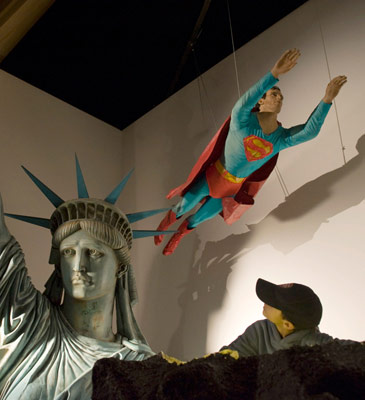
Superman flying over the Statue of Liberty in the British Film Museum
This museum is an eclectic collection of movie memorabilia arranged along the panelled corridors of London’s former council building. It’s not the most professional production, but there’s enough to grab the attention of most children, especially if they like superheroes and sci-fi.
For younger visitors, the best bit comes right at the beginning, as an animatronic T. rex from Night at the Museum 2 jerks menacingly to life just fingertips from the crowd. For maximum shriek value, don’t tell them about it beforehand. Across the hall stands the Headless Knight from Harry Potter – or perhaps it’s just his outfit.
There are detailed exhibitions on the legendary actor Charlie Chaplin, and the pioneering Jason and the Argonauts monster-maker, Ray Harryhausen; while the centrepiece of the museum is a circular chamber housing assorted props and costumes.
Kids’ Corner
The monster man
Ray Harryhausen made his first model after seeing the movie King Kong, aged 13. It was a bear made from his mum’s old fur coat. At the Film Museum, look for the skeleton Ray made for Jason and the Argonauts. The scene where Jason fights the skeletons lasts less than three minutes, but the models had to be moved 184,000 times!
8. Imperial War Museum (IWM)
War stories and weaponry
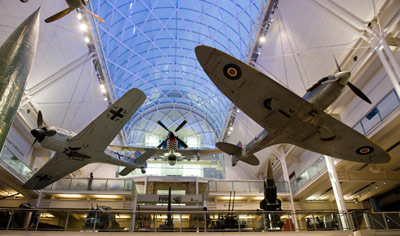
German Focke Wulf 190, North American P-51 Mustang and British Spitfire at the IWM
Housed in what used to be the Bethlem Royal Hospital, this enormous museum, which tells the stories of people’s experiences of war from World War I to the present day, tries hard not to be too gung-ho about its subject. But some kids (and adults) are bound to coo over the vast main hall, literally filled to the rafters with warplanes, tanks, missiles and other deadly hardware. Highlights include British Field Marshall Bernard Montgomery’s tank, a Nazi V2 rocket and a one-man submarine.
The IWM makes a real effort to appeal to families through a changing series of well-thought-out galleries and exhibitions. A Family in Wartime highlights the daily struggles of the Allpress family, who lived in Stockwell, London during World War II. Their story has been brought to life through a series of photos and interviews. The displays can be unflinching, but are always accessible, with stories to listen to and games to play such as spot the enemy bomber.
Several galleries explore what life was like at home and abroad during both world wars. An exhibition on the Holocaust, some parts of which might be too graphic for pre-teens (under-11s are not allowed to enter), traces the Nazi persecution and murder of Jews, and you can discover the extraordinary stories of bravery behind the Victoria Cross and George Cross in The Lord Ashcroft Gallery. There is also a library with a fascinating archive.
Kids’ Corner
Mission impossible?
Imagine you’re a soldier in the trenches. Find answers to these questions about your mission in the IWM Trench Experience:
-
What time will the raid start on enemy lines?
-
What is the signal to go “over the top”?
-
What should you try to bring back with you?
Evacuate!
More than 1 million British children were evacuated in World War II. It must have been scary but exciting to move to the countryside. Why not imagine you’re an evacuee, and write a letter home about what happens to you.
9. Florence Nightingale Museum
Throwing light on the Lady With The Lamp
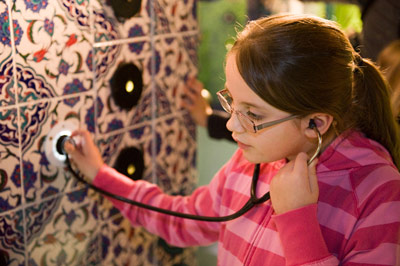
Using a stethoscope to listen to the audio tour at the Florence Nightingale Museum
This one-room museum, beside the ambulance bay at St Thomas’s Hospital, deserves top marks for making this woman’s extraordinary life story so engaging. Florence Nightingale worked as a nurse during the Crimean War (1853–6), and founded Britain’s first school of nursing in 1860. The museum is partitioned into three eye-catching “pavilions”: the first hemmed by hedgerows to represent Nightingale’s gilded youth; the next clad in Turkish tiles, to evoke the Crimean War; the third a mock-up of the bedroom where she spent most of her later life. She was often ill, but became the most popular woman in Victorian England thanks to her tireless campaigning for health reform. Kids can see the figurines that sold by the thousand to Florence’s fans, along with her pet owl (stuffed, of course) and that famous lamp.
Florence Nightingale is a genuinely interesting character, but there are also several gadgets to help keep kids’ attention, not least the ingenious “stethoscope” audio guide. Touch-screen challenges invite children to pack a medicine chest with useful kit for the battlefield, or wash their hands then scan them for germs. Elsewhere, short films bring the history of nursing up to date – including a look at the MRSA menace raging through modern hospitals. The Lady With The Lamp would not approve.
Kids’ Corner
Mary’s magic herbs
Mary Seacole, another famous nurse during the Crimean War, treated the soldiers using herbal remedies. Match the plant with the ailment it treated (you can find the answers at the museum).
-
Liquorice
-
Lemongrass
-
Cinnamon
-
Ginger
-
a Infection
-
b Diarrhoea
-
c Stomach pain
-
d Fever
Florence’s zoo
Florence Nightingale adored animals. Her tortoise Jimmy roamed the hospital in the Crimea, and the soldiers gave her a puppy. She even had a pet cicada – a kind of beetle – until it was eaten by her owl, Athena! You can see Athena (stuffed) at the museum.
